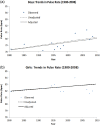Trends in resting pulse rates in 9-11-year-old children in the UK 1980-2008
- PMID: 24225271
- PMCID: PMC3888592
- DOI: 10.1136/archdischild-2013-304699
Trends in resting pulse rates in 9-11-year-old children in the UK 1980-2008
Abstract
Objective: Little is known about whether levels of physical fitness, which is related to adiposity and physical activity (PA), have changed in children, particularly the progressive increase in childhood obesity levels. We aimed to examine the time trends in resting pulse rate (a marker of physical fitness) among UK children, in order to better understand the trends in levels of physical fitness in recent decades.
Design and setting: We used a cross-sectional study design and included data on over 22 000 children aged 9-11 years (mean 10.3 years) from five population-based studies conducted in the UK between 1980 and 2008.
Main outcome measures: Resting pulse rate (bpm).
Results: Observed mean resting pulse rate was higher for girls than boys (82.2 bpm vs 78.7 bpm). During the study period mean pulse rate increased by 0.07 bpm/year (95% CI 0.04 to 0.09) among boys and to a lesser extent among girls, by 0.04 bpm/year (0.01 to 0.06) (p<0.05 for gender interaction). For boys, there was an indication that the trend was steeper after the mid-1990 s, compared to that prior to 1994 (annual increase 0.14 vs 0.04 bpm). The trends for Body Mass Index (BMI) accounted for only 13.8% (11.3% to 16.3%) of increase in pulse rate for boys and 17.2% (9.4% to 24.9%) for girls.
Conclusions: Increases in mean resting pulse rate have occurred during the period 1980-2008 in girls and especially in boys. The increase was not explained by increased BMI. The observed trends in children, though modest, could have important public health implications for future cardiovascular risk.
Keywords: Adolescent Health; Comm Child Health; Epidemiology; Obesity.
Figures


Comment in
-
Are physical fitness levels declining in UK children and should we be worried?Arch Dis Child. 2014 Jan;99(1):1-2. doi: 10.1136/archdischild-2013-305252. Arch Dis Child. 2014. PMID: 24334682 No abstract available.
References
-
- Armstrong N. Young people's physical activity patterns as assessed by heart rate monitoring. J Sports Sci 1998;16(Suppl):9–16 - PubMed
-
- Van Mechelen W, Twisk JWR, Van Lenthe G, et al. Longitudinal relationships between resting heart rate and biological risk factors for CVD; the Amsterdam Growth and Health Study. J Sports Sciences 16:S17–23 - PubMed
-
- Farinaro E, Stranges S, Guglielmucci G, et al. Heart rate as a risk factor in hypertensive individuals. The Italian TensioPulse Study. Nutr Metab Cardiovasc Dis 1999;9:196–202 - PubMed
-
- Kim JR, Kiefe CI, Liu K, et al. Heart rate and subsequent blood pressure in young adults: the CARDIA study. Hypertension 1999;33:640–6 - PubMed
-
- Voors AW, Webber LS, Berenson GS. Resting heart rate and pressure-rate product of children in a total biracial community: the Bogalusa Heart Study. Am J Epidemiol 1982;116:276–86 - PubMed
Publication types
MeSH terms
Grants and funding
LinkOut - more resources
Full Text Sources
Other Literature Sources
Medical
